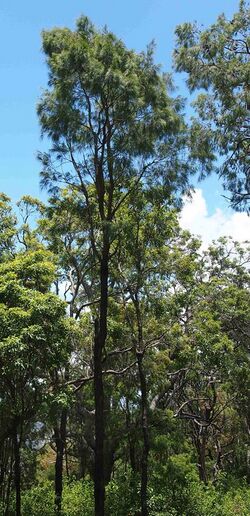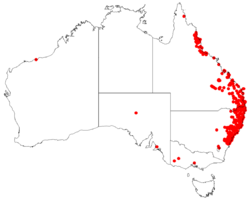Biology:Allocasuarina torulosa
| Allocasuarina torulosa | |
|---|---|

| |
| Allocasuarina torulosa | |
| Scientific classification | |
| Kingdom: | Plantae |
| Clade: | Tracheophytes |
| Clade: | Angiosperms |
| Clade: | Eudicots |
| Clade: | Rosids |
| Order: | Fagales |
| Family: | Casuarinaceae |
| Genus: | Allocasuarina |
| Species: | A. torulosa
|
| Binomial name | |
| Allocasuarina torulosa (Aiton) L.A.S.Johnson[2]
| |

| |
| Occurrence data from AVH | |
| Synonyms[2] | |
| |


Allocasuarina torulosa, commonly known as forest oak, rose sheoak,[3] river oak or Baker's oak,[4] is a species of flowering plant in the family Casuarinaceae and is endemic to eastern Australia. It is a slender, usually dioecious tree that has drooping branchlets up to 140 mm (5.5 in) long, the leaves reduced to scales in whorls of four or five, and the fruiting cones 15–33 mm (0.59–1.30 in) long containing winged seeds 7–10 mm (0.28–0.39 in) long.
Description
Allocasuarina torulosa is slender, usually dioecious tree that typically grows to a height of 5–20 m (16–66 ft). Its branchlets are drooping, up to 140 mm (5.5 in) long, the leaves reduced to erect, scale-like teeth 0.3–0.8 mm (0.012–0.031 in) long, arranged in whorls of four or five around the branchlets. The sections of branchlet between the leaf whorls are 5–6 mm (0.20–0.24 in) long, 0.4–0.5 mm (0.016–0.020 in) wide and more or less square in cross-section when young. Male flowers are arranged in spikes 5–30 mm (0.20–1.18 in) long, with 7 to 12 whorls per centimetre (per 0.39 in.), the anthers 0.5–0.6 mm (0.020–0.024 in) long. Female cones are on a peduncle 8–30 mm (0.31–1.18 in) long, and mature cones warty, shortly cylindrical to barrel-shaped, 15–33 mm (0.59–1.30 in) long and 12–25 mm (0.47–0.98 in) in diameter, containing brown, winged seeds 7–10 mm (0.28–0.39 in) long.[3][4][5]
Taxonomy
Forest oak was first formally described in 1789 by William Aiton, who gave it the name Casuarina torulosa in Hortus Kewensis from specimens collected by Joseph Banks.[6][7] In 1982, Lawrie Johnson transferred the species to Allocasuarina as A. torulosa in the Journal of the Adelaide Botanic Gardens.[8][9] Since it was the first species of the genus Allocasuarina to be named by Johnson, it is the type species of that genus.[10]
Distribution and habitat
Allocasuarina torulosa grows in open forest and on rainforest fringes in moister, more nutrient rich soils than A. littoralis at altitudes from 40 to 1,200 m (130 to 3,940 ft). It is widespread in north-eastern and central-eastern Queensland and on the coast and ranges of New South Wales, as far south as Macquarie Pass and Jenolan Caves. There is also an isolation population on Cape York Peninsula.[3][4][5]
Uses
The timber is reddish pink to brown.[11] It is prized by woodworkers and woodturners as a rare and exotic timber, often used in wood turnings, knife handles and other specialist items.[12] The rose she-oak has the largest contraction along the grain (12%) of any Australian wood and needs to be dried carefully to get full value as a useful timber.[13]
Ecology
The seeds of A. torulosa have been found to be a food source for the yellow-tailed black cockatoo.[14]
Use in horticulture
It grows from seed,[15] and cut or broken trees will often regenerate from the trunk.
This is a low-maintenance tree that will grow in a variety of soils and tolerate light frosts.[15] In the United States , it is suitable for USDA hardiness zones 8–11. It may be susceptible to Armillaria and Phytophthora.[16]
References
- ↑ IUCN SSC Global Tree Specialist Group.; Botanic Gardens Conservation International (2020). "Allocasuarina torulosa". IUCN Red List of Threatened Species 2020: e.T177363617A177375942. doi:10.2305/IUCN.UK.2020-3.RLTS.T177363617A177375942.en. https://www.iucnredlist.org/species/177363617/177375942. Retrieved 19 November 2021.
- ↑ 2.0 2.1 "Allocasuarina torulosa". https://biodiversity.org.au/nsl/services/apc-format/display/82362.
- ↑ 3.0 3.1 3.2 "Allocasuarina torulosa". Australian Biological Resources Study, Department of Agriculture, Water and the Environment: Canberra. https://profiles.ala.org.au/opus/foa/profile/Allocasuarina%20torulosa.
- ↑ 4.0 4.1 4.2 "Allocasuarina torulosa". Centre for Australian National Biodiversity Research (CANBR), Australian Government. 2020. https://apps.lucidcentral.org/rainforest/text/entities/Allocasuarina_torulosa.htm.
- ↑ 5.0 5.1 Wilson, Karen L.; Johnson, Lawrence A.S.. "Allocasuarina torulosa". Royal Botanic Garden Sydney. https://plantnet.rbgsyd.nsw.gov.au/cgi-bin/NSWfl.pl?page=nswfl&lvl=sp&name=Allocasuarina~torulosa.
- ↑ "Casuarina torulosa". APNI. https://id.biodiversity.org.au/instance/apni/459378.
- ↑ Aiton, William (1789). Hortus Kewensis. 3. London. p. 320. https://www.biodiversitylibrary.org/item/23434#page/323/mode/1up. Retrieved 18 August 2023.
- ↑ "Allocasuarina torulosa". APNI. https://id.biodiversity.org.au/instance/apni/499448.
- ↑ Johnson, Lawrence A.S. (1982). "Notes on Casuarinaceae II.". Journal of the Adelaide Botanic Gardens 6 (1): 78. https://www.biodiversitylibrary.org/page/61978679#page/90/mode/1up. Retrieved 5 August 2023.
- ↑ "Allocasuarina". APNI. https://id.biodiversity.org.au/instance/apni/499181.
- ↑ "Rose sheoak | The Wood Database - Lumber Identification (Hardwood)" (in en-US). https://www.wood-database.com/rose-sheoak/.
- ↑ "Allocasuarina torulosa Forest Sheoak Tree -" (in en). https://www.daleysfruit.com.au/buy/allocasuarina-torulosa-forest-sheoak-tree.htm.
- ↑ "She-Oaks in a Rural Landscape". https://glossyblack.org.au/wp-content/uploads/2017/06/Fact-Sheet-2-Living-with-Glossy-Blacks-She-oaks-in-a-rural-landscape.pdf.
- ↑ "Allocasuarina torulosa". http://plantselector.botanicgardens.sa.gov.au/Plants/Details/775.
- ↑ 15.0 15.1 Stewart, Angus. "Allocasuarina torulosa -- Forest she-oak". https://www.gardeningwithangus.com.au/allocasuarina-torulosa-forest-she-oak/.
- ↑ "UFEI - SelecTree: A Tree Selection Guide". https://selectree.calpoly.edu/tree-detail/allocasuarina-torulosa.
External links
 "Forest Oak". New International Encyclopedia. 1905.
"Forest Oak". New International Encyclopedia. 1905.- Occurrence data for Allocasuarina torulosa from The Australasian Virtual Herbarium
Wikidata ☰ Q4732997 entry
 |


